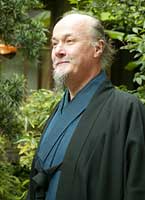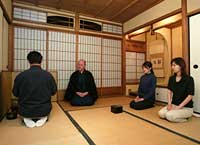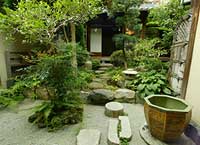|
|
|||||||
|
|
|||||||
|
|||||||
| | Web Japan >> | Trends in Japan >> | People >> | Søren M. Chr. Bisgaard | |
|
SØREN M. CHR. BISGAARD Sharing Eternal Moments Through Tea (February 18, 2004) Tea is enjoyed by people all over the world in many different ways. Usually it is prepared with great care using beautiful utensils in accordance with the culture in which it is drunk. "Nowhere, though," notes Søren Bisgaard, a Danish-born tea master of the Urasenke school who now makes his home in the city of Kyoto, "has the drinking of tea been elevated to such a high artistic and cultural level as in Japan." Chanoyu, the ceremony surrounding the serving of powdered green tea, is "one of the greatest achievements of Japanese culture," Bisgaard claims. "The quality of tea itself is the very best, and the fact that you imbibe the whole leaf in its powdered form insures you get all the health benefits and mental effects contained in tea. The philosophical and aesthetic values central to chado [the 'way of tea'] are a true contribution to humanity that can be shared with people in other cultures to enrich their lives."
Affinity with Tea "I was 30 and I had come to the other end of the world," he recalls. "So I was very happy when I was accepted as a student." He enrolled in a three-year course in the school's international division and has since cultivated a very close and rewarding relationship with Urasenke, having received his chamei, or tea name, directly from the grand tea master. His fondness for tea actually goes back much further. Lured by an interest in philosophy and ancient history, he visited Greece while still in high school and later traveled to the Middle East and Afghanistan and eventually spent much time in India. Everywhere he went, he found himself frequenting tea houses, which became his "home away from home." While studying Buddhism and Indian philosophy he happened upon a small book that would change the course of his life: The Book of Tea, an introduction to Japan's artistic and spiritual tradition written in 1906 by Okakura Tenshin. "I was influenced by the book from my first reading. I was 19 at the time and became enchanted by the underlying philosophy of tea as well as traditional Japanese architecture and garden aesthetics." The book was a constant companion on his journeys throughout Asia and a source of inspiration, and it eventually prompted him to travel to Japan.
Here and Now In chado one learns to value each fleeting moment. "Each encounter between the host and guest is unique. It has never been experienced before and will never be repeated again. It exists only in that very moment, so you have to pay attention to the present with all your heart and mind. When everyone's attention is focused on the moment, that moment becomes eternal." Bisgaard's appreciation for the here and now has, naturally, dampened any desire to go chasing after promises of a lucrative future. "I could spend my time making money, but then I would have to compromise and do things that I don't agree with. I may be poor as a result, but what I have you cannot buy. I don't own this house, and I don't have any pensions. But as long as I'm practicing chado I am at peace with myself and doing something that other people may appreciate. And somehow I feel that that would be enough. There's no safety net whatsoever. I trust in the divinity of life itself." Sadly, he feels, many Japanese themselves have made the opposite choice. "For example, when I first came to Kyoto there were many gardens like the one we have here, but now there are few left. Just working with the plants takes out a lot of stress and relaxes your mind. It keeps you in touch with the changing seasons. All these things were completely normal until quite recently and gave people a deeper sense of belonging, purpose, and fulfillment. TV cannot substitute for those things, and neither will pachinko, karaoke, or computer games. All these machines have stolen the Japanese mind and heart." Bisgaard believes that they have also distorted the way people spend their time. "So many people have no time on their hands because they are so busy working to pay for the machines that supposedly make life more convenient. These machines have not liberated man. On the contrary, we have become subservient to them. We have to work harder to obtain all that we need, and so there is no time to live. "If you look at so-called primitive people, they spend maybe two to four hours a day doing what is necessary to maintain life. The rest of the time they spend with their family, being artistic, playing music, dancing, or just enjoying themselves. The people in less developed countries may be poorer by World Bank standards, but they have a richer life."
Transplanting Chado This poses a challenge that is quite different from those encountered in practicing or teaching tea in Japan. "Chado integrates all sorts of uniquely Japanese elements, some of which are completely alien to others. In transplanting a tree, we have to cut off the small branches but leave the big ones intact and protect the roots. In due time the transplanted tree will acclimatize and begin sprouting new branches, flower, and bear fruit. In a similar manner, when transferring chado to a foreign culture we have to maintain the roots and try to convey the essence. After a period of blind copying and doing everything like in Japan, eventually there will be an adaptation to local conditions, climate, and culture, and only then we will have succeeded in truly transplanting the Japanese treasure that chado is. "Chado is, in its subtle way, perhaps one of the largest contributions Japan has ever made to the cultural life of the world. Japan in the past has inspired many artistic movements in the West like impressionism and art nouveau and spawned new design concepts. Chado," Bisgaard believes "can have an even deeper impact and can also make a big contribution to international goodwill and peace."
Søren M. Chr. Bisgaard Copyright (c) 2004 Web Japan. Edited by Japan Echo Inc. based on domestic Japanese news sources. Articles presented here are offered for reference purposes and do not necessarily represent the policy or views of the Japanese Government. |
|
|||||
|
||||||






